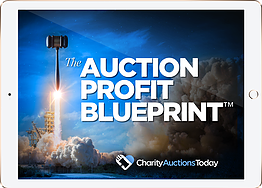DOWNLOAD The Auction Profit Blueprint
The 4 tools BIG organizations use every time to skyrocket auction profits!
The Step-By-Step Guide to stop leaving thousands on the table.
Boost your auction’s potential with social media fundraising post examples from CharityAuctionsToday. Make sure everyone on your social channels sees your fundraiser.

Using social media is a must for even the smallest nonprofits—maybe even more important for them! Social media gets the word out about your work. And using social media purposefully to help with your fundraising is a great strategy to yield more funds.
Even if you’re not an avid social media poster, we’re about to give you an in-depth look at how to share meaningful, attention-getting, content on Facebook, Instagram, and Twitter. We’ll even include some thoughts on TikTok (even though it’s not really our scene).
There are many different social media platforms, but let’s stick with the main three: Facebook, Instagram, and Twitter. Our recommendation is go with one or all of these three, where the majority of people are active members. There are certainly other channels out there (TikTok, LinkedIn, Tumblr, and others), but you’ll want to think about which your audience is using and where it will be most effective to focus your efforts. You don’t necessarily need a presence on every platform out there, just the ones that will benefit your organization.
Build your fundraising auction today in as little as five minutes: start here.
Facebook is still very popular, despite the fact that a lot of younger generations use it less than older ones. It can be especially useful for local nonprofits, as it is a great platform to reach your local community.
The Chicago Catcade, below, is known for a sassy and down-to-earth tone, and their posts garner a lot of attention purely for their humor, not to mention their dedication to rescuing our feline friends.
Credit: Catcade Facebook post, accessed 6/9/23
Although all social media tends to feature visual media (pictures, banners, videos, etc.), Instagram is the visual medium online. Not every nonprofit will have a lot of pictures to share day-to-day. Explore nonprofits with similar missions to see if they have compelling Instagram content or if it feels like they’re reaching a little.
The IRC, featured below, is a large organization with designers at their disposal, and can create striking and emotional imagery with calls-to-action laid over them. Your organization may not be as large, but even if you’re just taking pictures of volunteers you can find ways to highlight your work on Instagram.
Credit: International Rescue Committee Instagram post, accessed 6/9/23
Sample hashtags: #charityauction #auctionforcharity #dogood #bidforcharity #onlinecharity #fundraising #fundraiser
We’re on Instagram, tag us and we’ll help you promote your online auction for charity.
Twitter is best for fast-paced nonprofits with time-sensitive needs, as well as those dealing with ongoing current events or those that are simply in the public eye often. If your cause revolves around asking people to take immediate action—such as donating to emergency relief or calling on voters to call their representatives—you need to be on Twitter.
Credit: Lakota People’s Law Project Twitter post, accessed 6/9/23
Tag us for support @IDTCharity.
Is there a story behind your fundraiser? Has this been a journey? Are you helping someone else? What’s the main reason that drives you to fundraise?
Summarize it in a few sentences, add a magnetic image, and post the story to social media. Ask your friends to share your post! This is how to use social media to boost your fundraising goals
Posting it to your personal pages is fine but be sure everyone can read it and your friends can share it with their friends. If your nonprofit or cause doesn’t have its own business profile now is a good time to create one. Business pages are more easily shared regardless of a person’s list of friends or followers.
Make your social media posts shareable. Be sure that the privacy settings are set to global (or all) so that everyone can share it and all of their friends and followers can see it too. Make sure the images are vivid and bright. Give them a reason to want to share it by using social media to boost your fundraising goals
This is where you tell your audience what you want them to do. Be specific.
For example, “Please support our school by sharing this to your timeline” or “Post this to your wall and ask your friends to share it too!” and “Thank you in advance for sharing this with your friends!”
Share and retweet other nonprofits and voices in your nonprofit’s area of interest. Get conversations going by sharing other people’s and organizations’ posts, and help their own fundraisers or calls-to-action get more attention.
Think about local figures who might be able to lend their voice to your cause. Whether it’s the mayor or a favorite local musician or performer, their own social channels can help amplify your message. Tag or privately message them to ask if they’d be willing to share or retweet posts of yours, especially if they’re particularly relevant to their work in the community. As an added bonus, sometimes these online interactions can become in-real-life relationships that can help your nonprofit reach new heights.
Everyone says “be yourself,” which is certainly good advice, but in modern life with the pressures we sometimes feel from social media, it can be difficult to stick to it. Similarly, you might feel some anxiety about posting in a professional manner on your organization’s behalf, rather than on your own social profiles.
We recommend figuring out a way to post that feels natural and comfortable to you. You can acknowledge tough subjects and you can take a stand on controversial issues if they’re relevant to your cause. Being authentic means having opinions and sharing emotions, which can not only be expressed in a professional manner but also help prove to your audience that you’re a real person working hard for your cause.
Using social media to boost your fundraising goals is a smart strategy. Social media fundraising post examples aren’t just about posting and reposting your fundraiser but also about maintaining a continuous presence online and making sure your followers see all the hard work you do, not just your auctions or events.
DOWNLOAD The Auction Profit Blueprint
The 4 tools BIG organizations use every time to skyrocket auction profits!
The Step-By-Step Guide to stop leaving thousands on the table.


Learn the 4 tools BIG Organizations use to skyrocket their auction profits!
Stop leaving thousands of dollars on the table by following this step-by-step guide